Artist Dennis Oppenheim died in New York on Friday, January 21, of complications from colon cancer. Renowned as one of the seminal artists in the development and spread of conceptual art, land art, and body art in the 1960s and 1970s, his early work has become legendary for its cogent conflations of artistic categories and processes, zen-like sparsity of objects and aesthetic ideas, and negation of the museum and gallery system. In the 1980s his work took a decidedly material turn, embracing the gallery and museum but filling them with unwieldly and unruly motorized installations. In recent decades he has become known for a brand of public sculpture best described as "nervous" and "evasive." It's a characterization denoting Dennis' perverse joining and loose organization of unstable and unreconcilable signage ("architectural mirages" "flying foundations") that defy "truth to materiality" maxims, shun categorization, and imbue objects and materials with a projected defiance that forearms them to squirm loose from any ideological hold we attempt on them. If Dennis' art tolerates interpretation at all, it's to embody the artist's fidgeting relativism, and to extend his subjective neurological state into the physical and ideological space shared with an often baffled audience.
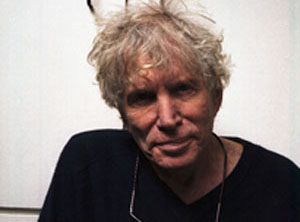
When I received the news last week that Dennis Oppenheim had died, I was immediately transported back some thirty-five years to my first encounters with his art. I was eighteen, a freshmen studying art and philosophy at the SUNY College in Buffalo, New York, when I met two older students, the artists Robert Longo and Cindy Sherman. Both were just starting up an artist-run alternative space named Hallwalls at which they invited both local and international artists to show and discuss their work. Robert is the one who introduced me to art critic Lucy Lippard's just-released Six Years: The Dematerialization of the Art Object From 1966 to 1972, a book I made my bible on contemporary art. Although there were hundreds of artists featured in the survey, there were two artists I came back to repeatedly--Robert Smithson and Dennis Oppenheim. The descriptions and depictions of Dennis' land art and body art were unlike anything I'd ever encountered and wanted to know more about. It was only a few months later that I received my wish of laying eyes directly on one of Dennis' earth works, and it turned out the work was among his most spectacular.
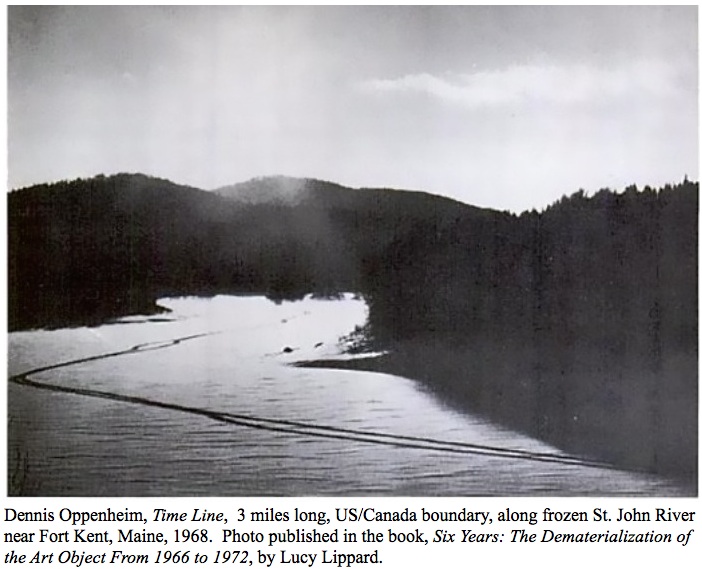
It was only natural that I'd be drawn to Artpark, an old industrial spoils dump site in nearby Lewiston that had just been converted into a theme park for the arts. The artists at Hallwalls, all of whom were a few years older and more knowledgeable about contemporary art, were raving ecstatically about the massive land art that Dennis was laying across the park. As soon as I could scrape up the bus fare, I descended on the park, a fortunate approach considering that Dennis had engineered the work to be seen for maximum viewing impact from atop the Niagara Escarpment, part of the mighty gorge from which tumbles Niagara Falls a few miles away. Looking down from the escarpment, I saw what was being called Identity Stretch sprawled majestically across several acres of the spoils field. The signage was unmistakable--two giant fingerprints superimposed in black against the green and brown plateau floor.
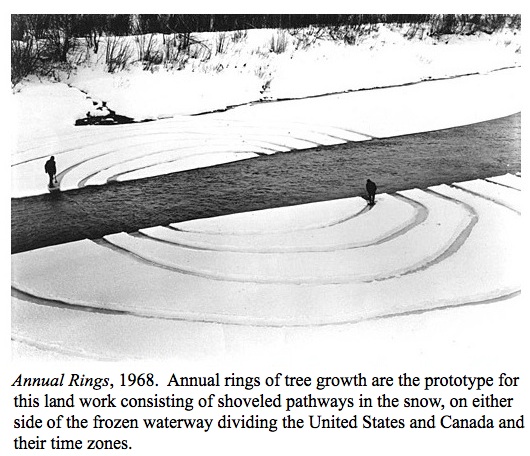
On that early summer morning in 1975 I reacted with unrestrained awe as I imagined mythological and extra-terrestrial narratives to correlate with what I saw. When I later that day learned the mundane facts informing the work, I was even more impressed by the simple and obvious profundity of it all--the best kind of profundity for being universal and forever in plain sight. It turned out I was looking down onto two thumb prints that had originally been impressed on a strip of rubber tape which was then enlarged and transferred to the spoils field by a spray cart dispensing black tar. Identity Stretch was to be one of Dennis' last earthworks, but it also is his most personal. The meaning the work held for Dennis perfectly complimented the magnitude of the event in my teenage mind with an equally powerful ethos: the larger of the prints was his, and the smaller that of his son Erik. It was all I needed to know about the signage to evoke the work's larger reference to the progression of time and the succession of human genealogy. Despite what I now consider the grandiosity, even the megalomania of the gesture--and the unfortunate choice of the eco-toxic tar--the work retains its hold over my imagination--a hold made more gripping by the signs of father and son overlapping. The use of Dennis' body in making his primal mark on the landscape would be evocative enough, but in adding representation of his son overlapping him, the signage assumes a timeless aura--the kind that in another century would inspire romantic phrasing of human transcendence over mortal limits. In an earlier age still, it would speak of ritual blood bondage and coming-of-age passage. In our scientific age, the overlapping prints imply a continuum of DNA from which we can infer our only approach to immortality--the chain of human issue unfolding over millennia.

Seventeen years later, without knowing the impact Identity Stretch had on me, Dennis presented me with a gift that ironically related to the art and themes I found so affecting in 1975. I had just written an essay for the periodical Parkett on Dennis' mid-career work (some of which is incorporated below), and the work he gave me in gratitude was a lithograph he called Extended Expressions. It was made after a videotape Dennis had shot in 1971, which happened to be a personal favorite among the many artists' tapes I'd seen in the 1970s--though I don't remember ever telling Dennis. The litho and the video again incorporates Dennis and his son Erik, only this time the pair recorded a succession of exaggerated mugshots prototyped by Dennis and mimicked immediately after by Erik. Since the work is reproduced below with Dennis' accompanying text describing the work's process and intent, I won't belabor description of the work except to comment that it's one of the most apt enactments I've yet seen of the enculturation bestowed by a father on his son, and the inevitable if innocently unconscious narcissism that bonds them. I don't know why Dennis thought to give me this particular lithograph--he had hundreds to choose from. Perhaps it's because I now knew the adult Erik Oppenheim, who also was an artist and whose work I admired. More likely it was just by chance that Dennis chose a work echoing the earthwork that had so deeply affected me.
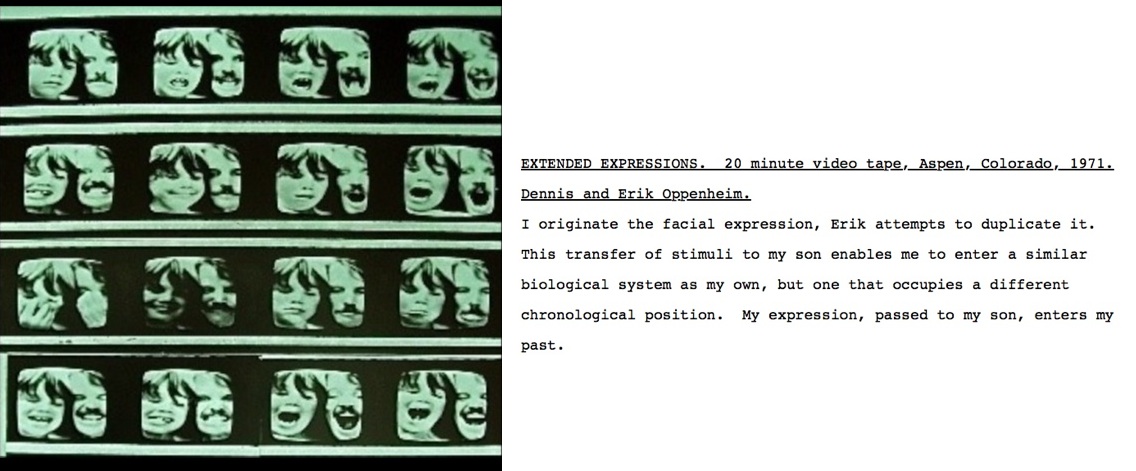
It's nearly another twenty years since I installed Dennis' litho in my home, and I still enjoy running my eyes over the video stills of the filial ritual playing out. Needless to say, when I heard of Dennis' passing, Extended Expressions became the focal point for my reveries of the man and his art. (And doesn't this tell us that art now performs the consoling function once supplied by the sacred images and statues of a faith?) In fact, Dennis and Erik look down on me as I write this, making me realize I'm enabling Dennis to extend himself through me, and in turn through you, just as he intended. It's the kind of chain of extensions by which Dennis became known in his early art. By extending himself, I mean that much of Dennis' work, certainly the two works I've just described, are comprised by his mindful projection of aspects of his nervous system and cognitive state into our lives in such a way that it extends our own experiences, while making us more alert to them in ways that exceed the usual perpetuation of the artist through her work. The test will now be whether Dennis' extension--his nervous system and remnants of knowledge and memory--survives Dennis in death, and even after in the passing of the generations who knew his mark on the culture of art first hand. Speaking for myself, both Identity Stretch and Extended Expressions imply a synchronous "renewal through perpetuation" and "perpetuation through renewal" implicit in all life-death equations. In Dennis' case it's a renewal and perpetuation achieved through his art and his children, which he at some of his best moments and in some of his best art made one and the same.
There is a third work by Dennis that I'm adding to this account of generational extension generally and Dennis' project of extending his personal neurology and cognition, in this case the extension of the father to the son, and then back from the son to the father. Two Stage Transfer Drawing is a video and photographic record of Dennis drawing on Erik's back as Erik attempts to replicate on the wall in front of him the lines he feels being physically described on his back by Dennis. On the videotape, Dennis verbally describes the event as he first takes the lead in drawing, and from there on father and son take turns drawing on each other's backs. Initially the visual drawing is invisibly shared, though it is felt described by the nerves on the back of the recipient. It's a drawing literally drawn through the nervous system of the recipient, who then makes the drawing on the wall that both can finally share visually. It's a process that is awkward and cumbersome to express in words, but appears exceedingly elegant in Dennis' video and photo depictions.

Two Stage Transfer Drawing is a work that holds the key to understanding the larger potential of Dennis' project of extending his neurology to the neurology of other people, either directly or through objects, a project that can arguably be best described as the artist's immanence. By immanence, I mean the sustained presence of the artist 's nervous system and cognition in the objects he has some hand in making, appropriating, and distributing in the world. Conventionally, the immanence of the artist is what we recognize as the perceptible hand of the artist in the art: the style, sensibility, brushwork, aura, gesture and signature by which we identify the work's author. Immanence comprises an important part in all Dennis' work, though the process of extending his nervous system, perception, and cognition is more transparent, even naked, in his early land, body, and performance art.
Take for example Dennis' 1974 video and sculptural installation Recall. Writing about the work's conception, Dennis notes he chose turpentine to be used as a device to activate his memory when inhaled. "I stuffed cotton saturated with turpentine into my nose, and like a drug, it induced an alteration of a past region in which the smell prevailed, and I verbalize in a kind of rambling stream of consciousness monologue." But Dennis has also selected turpentine to extend, or to form a chain from, his neurology to the neurologies of his audience. The monologue, issued by video from a seemingly disembodied mouth shot in extreme close up, and which the audience must take on faith to be his, recounts memories of his life as an art student forced to breathe in the fumes of turpentine around him. The narrative makes eminent sense to the audience, who are presented with an unembellished 8-foot-long industrial tray filled with black-tinted turpentine. For those viewers captivated enough to stay and absorb both the meaning of the work and the high that comes with breathing in the turpentine, the work becomes a partial sensory transference of Dennis' memory. In effect, the experience of breathing in turpentine and its association with Dennis having done so at some earlier time, are made imminent in the viewer first through the videotape, monitor, and reflecting turpentine, and subsequently through the effect of getting high off the turpentine with "Dennis." It is a process that in effect becomes a transfer both cognitively through the video monologue, and phenomenologically through the scent and physiological effect of the turpentine.

Recall doesn't merely relay information regarding the signage of an artist's experience, as would a conventional narrative and visualization. It also extends the experience of the artist's reaction to the turpentine to a willing audience. Recall was one of Dennis' first installational sculptures, so it in retrospect seems logical that it would extend his body art--what I prefer calling his neurology or nervousness--through the videotape, monitor, metal pan, turpentine, and cumulatively through the experience of hearing the narrative and feeling the swoon of the fumes. Dennis' neurological medium transcends the language of art, by which I mean it extends beyond the articulated signage employed with visual marks, objects, or phonetics to the experience they are intended to reference. And when we transcend signs we are left with the immanence of an artist communing with the present viewer, something difficult to achieve in an art form conventionally extended only with signs and not the materiality and sensory essence of the cumulative experience itself.
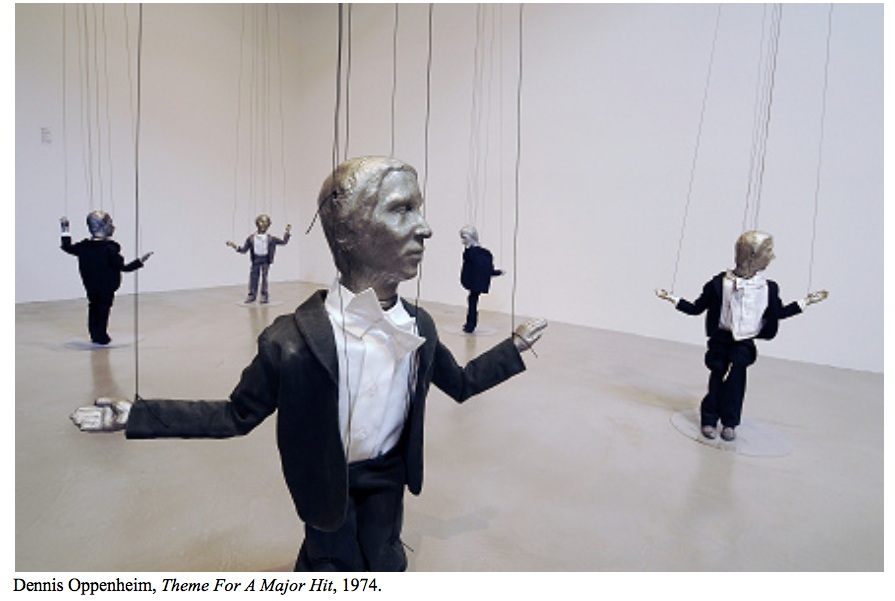
Dennis was by no means the first artist to align visual art with other sensory experiences, but he is among the first to convert non-visual or aural experience into sensory articulation of meaning. That Dennis does so while circumventing what otherwise seemed like gimmicky, trite, and common theatrical props or appendages in the hands of less semiotically astute artists accounts for why he was able to make non-visual sensory stimulation structurally central and essential to the art experience. That he achieved his sensory effects in his early work by "impoverishing" his art--stripping it down to unadorned materials and experience--signals that Dennis also aligned himself to some degree with the valences of minimalism and post-minimalism, which assumed the now famous dictum, "less is more." But Dennis, like his contemporary, Vito Acconci, for a few years indulged what by the day's conventions were "unaesthetic," "unpleasant," "monotonously uninviting," downright gritty visual and oral presentations and signage that, despite expectation, overrode the work's initial alienation. Like Acconci, Dennis conveyed an immanence in such work that compelled viewers to stay with the work and commit to suffering through the disorientation and discomfort to which he evidently would himself succumb while making his art--which in Recall meant succumbing to turpentine fumes. And in the manner of ascetics, the more Dennis stripped away the layering of tropes and artifice conventional to the art of the time, the more he was able to resonate and sustain his immanence in the art. It was an aesthetic asceticism and heightening of immanence that would come back to haunt him later.
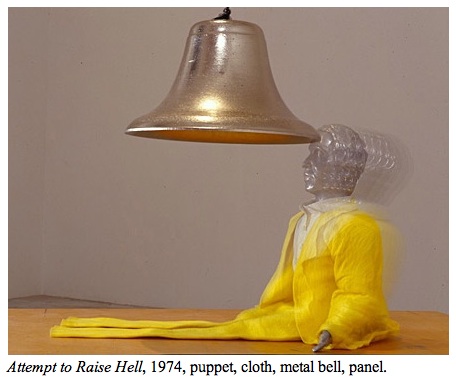
Dennis' art became more elaborate in the 1980s as he began lavishing his installations with an array of objects, materials, processes, and artifice that eclipsed his presence. His immanence seemingly receded as he became increasingly less narcissistically focused and more concerned with external social and cultural reflections. We can trace Dennis' apparent "disappearance" into his work as far back as 1974, beginning with a series of marionette installations, exemplified best by the work Theme for a Major Hit, a gallery installation of twenty-four marionettes motorized to dance to music. It's both a fortunate and unfortunate series of installations. Fortunate in that the cliched signage of the marionette has always conveyed the faux disappearance of the puppet master and thereby signaling that Dennis' immanence is still central to the work. It's unfortunate for the same reasons--that the signage of the puppet is cliche; that it has always conveyed the immanence of the puppet master and thereby too easily gives away what Dennis is up to. I remember that at the time I rather rigidly thought that the marionettes conveyed a pronounced and hackneyed theatricality that repels rather than entices art audiences craving the avant-garde that Dennis struck me to be abandoning. And yet, as I thought all this out in my first encounter with Dennis' marionettes, and as I stood there consoling my disappointment, my ears slowly helped me come to the understanding that Dennis was addressing my disappointment right then and there. It had been telling me the whole time, but I ignored the singing that accompanied the maniacally dancing marionettes: A song I'd later find out was sung by artist and impresario Diego Cortez, with lyrics written by Dennis. But at the moment of my delayed epiphany, the lyrics explained it all: "It ain't what you make, it's what makes you do it."

Was Dennis as uncertain as his audience about his new direction? Perhaps acknowledging he was in a creative rut? Or was he anticipating audience disappointment, thumbing his nose at the aesthetes and art dealers who, like me, expected "serious" art? In either case, Dennis answered us mocking with his singing self-appraisal. And then I noticed what others who knew Dennis, or saw enough photos of him, likely recognized. That Dennis really hadn't disappeared in the marionette work at all. In fact, each marionette is his self portrait. Surely with so many motorized self-portraits dancing in one contained space, he must be telling us something about the genesis and intent of the work's reflection of his self-doubts. What it was, I couldn't guess. That is, until a single, sitting Dennis effigy, in the work Attempt to Rase Hell, and after a prolonged inactivity, startlingly lunged forward to smash its head--Dennis' head--against a large metal bell. Although the discomfiting effect of the marionette cliche was still not fully dispelled, the sudden violence analogizing despair and the desire for self-annihilation, despite its comic overtones, decidedly disrupted the veneer of charm and artifice covering over the deeply disturbing sight of so many narcissistic effigies. I can't remember whether or not I knew then that we, his audience, were beginning to catch sight of the demons that Dennis was coyly both asserting and denying to be driving him to make art.
The work that I would come to know in the late 1980s and early 1990s came on the heels of Dennis' professed recovery from a nervous breakdown. About his personal crisis I know little except that for a few years, in the early 1980s, Dennis claims to have made no art. It's an inactivity that may explain why his re-emergence brought with it an outpouring of diversely metaphorical, yet perversely enigmatic sculptural installations and public art that would issue from him for the next twenty years. The most complicated work consists of constellations of prefabricated industrial materials and remnants of consumer items. In the first years of the new work's release, Dennis' commentators both publicly and privately bemoaned the abandonment of his earlier, reflexive and sparsely-structured conceptual, land, and body art. Missed most of all was Dennis' zen-like austerity and reliance on simple gestalt signage and processes that came to be branded as the dematerialization of art. Although it was clear that Dennis was still marking out new boundaries for art, he was also now not only veering back to materiality, he closed in on the more conventional and eroded terrain of assemblage and constructivist sculpture. In those years Dennis seemed plagued by the desire of some critics to discuss and compare his work with the poststructuralist and post-minimalist principles applicable to the work of Bruce Nauman. But unlike Nauman, who all the while remained intimately masterful at testing the parameters and limits of the signage and structure of his chosen media, Dennis sought to inhabit his signage and structures--to make them nervous with feeling. It's the difference between the two artists of viewing, measuring, and critiquing objects and imagery from without (Nauman) and animating them conceptually, poetically, and empathically from within (Oppenheim).

Dennis' immersion in irrational and perverse objects no longer afforded viewers the clarity and transparency of his earlier art. It took me at least a decade (somewhere around 1992), to see that Dennis' work still schematically extended his nervous system into the world at large--and to which we, his audience, could open ourselves. I said that Dennis was now making objects nervous with feeling. What I mean is he was making them neurological, as extensions and markings of his nervous system. To put it crudely, Dennis was entering the world of inanimate objects. If this sounds theological or schizophrenic (some might say they're the same), we need only remember that when Dennis the man broke down some years before, so did his art, and he apparently never again felt the need to unify it with a single conceptual scheme or model. Dennis' work of the 1990s and 2000s remained fractured, but by now Dennis projected an I-could-care-less-what-the-artworld-wants confidence that made the fracturing a virtue as he traced the myriad cognitive pathways through every object to draw his interest. It's as if Dennis could look at, into, and through an object to see its structures on multiple levels. It's the kind of perceptual ability afforded only those persons who have disassembled, or have never been conditioned by, the naive picture of unified truth.
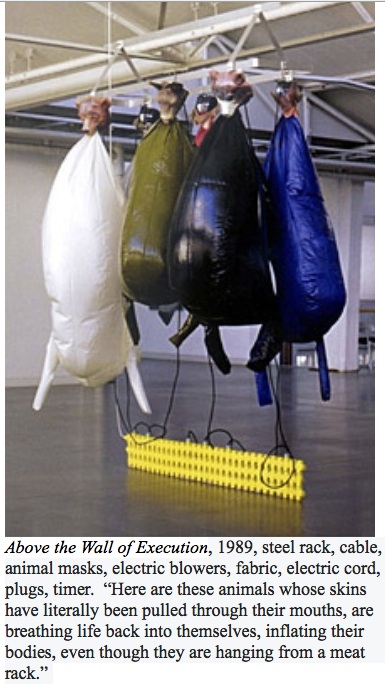
In this respect Dennis is a throwback to the poetic vein of existentialists who emerged with the end of the Second World War (I think particularly of the artists that Harold Rosenberg championed). By this I mean that in place of the rational, formalist, and critical functions and overlay of most conceptually derived sculpture (like that of Nauman), Dennis offers us the bare neurology not just implicit in art, but in all humanly-crafted objects and in the mediation of all experience with objects and materials. Not since painterly expressionism has a model of human nervousness, neurology, and neurosis been so openly represented or displayed. But whereas the neurological basis of expressionism makes the physical mark of the artist on the medium central to her art, Dennis' modeling of unstable neurologies and the delusions they impel is disclosed through an assemblage of the objects and materials of industrial production and consumption that appears seriously askew, what objects would look like if they could be neurotic.
If Dennis must at this point in his career be compared to other artists, it can only be to Joseph Beuys and Sigmar Polke. If the analogy at first seems absurd, it's because the three bodies of work from the vantage of outer appearances alone, defy comparison. It's only after we consider that Dennis, Beuys and Polke all regard their art descending from the productions of shamans and alchemists that we begin to understand how Beuys and Polke shared with Dennis the notion of the artist's natural immanence in the objects he touches to the point of pronouncing that immanence in the foreground of artistic processes and concerns.
It's this image of the artist-as-shaman seizing hold of artists recoiling from rampant consumerism that may help us understand why Dennis' work phased successively into various stages of idiosyncratic assemblies of consumer items, prefabricated industrial materials, theatrical props, and finally operatically engineered architectural conundrums rather than continue on with his prior excursions into performance-based body art and video. Since I've now entered the province of an essay I wrote in 1992 about Dennis' work for the publication Parkett, I'll simply paraphrase from fragments of the essay I call "A Poesy of Diagnostcs or the Object Neurology of Dennis Oppenheim." It's an essay in which I claim that, despite there being no theory or foundation unifying or governing Dennis' work, there is still what I regard as his intent on achieving object immanence that makes his work appear as if the objects have minds of their own--and interests at odds with human interests. What I'm saying is that Dennis came to figuratively "animate" objects by making them sculptural allegories that, despite being largely without motion, suggest not just movement, but willfulness in their disarray, their lurid and senseless sculptural babble mixing in tracks that, though in reality are highly thought out and engineered, look to be chaotically skewed anti-structures, objects functioning as metaphors for states of collective dysfunction. The more Dennis became fascinated with manufacturing and engineering, the more he seemed to turn his vision outward, but only to make allegories referential to the illogical events of human affairs at odds with the world around them.
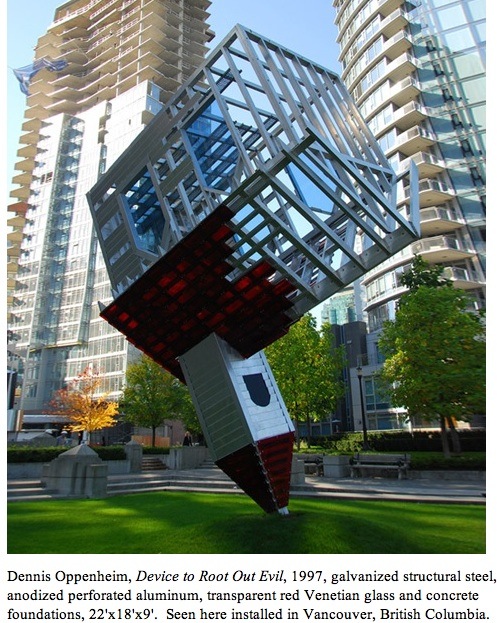
Whether found or designed by Dennis, the assembled objects that inhabit his work from the 1980s through the 2000s are produced in response to consumer demands colliding with an emergent consciousness of the threats industrial and post-industrial societies pose to our natural and pre-industrial support systems. I don't mean that Dennis responded to the art market by conceding to the collectors and museums who gauge the value of art. Dennis' art in fact for several years had the effect of thwarting collectors and museums. On the other hand, the materials and metaphors from which Dennis came to build a repertoire, came to signify Dennis' triumphal emergence from narcissistic production while allegorically referencing threatened oil supplies; shortages of lumber; the systematic eradication of the world's rain forests; crops destroyed by acid rain; melt-downs of nuclear cores; the warming and evaporation of lakes and streams; land-fills diminished as the swelling supply of non-degradable plastics choke the environment; the extinction of animals and encroachment on their habitats; and then there is always religious denial and dysfunction stalling social and political development. This is what Dennis means when he claims he wants "to retain the energy of something almost ready to fall, in a work that seemed to be unfixed, having another scene to portray." In its dark portrayal, Dennis' late art offers a diagnostics of societal pathology and technological hazards of industrial and post-industrial civilization, its architecture and hardware in play without foreseeable resolution. We see this in his outdoor monument to religious irrationalism, Device to Root Out Evil, which literally turns one of the presumed foundations of American society and culture, the New England-styled church, both literally and metaphorically upside down, even as it structurally mirrors the patterns of the high rises that surround the work's installation in urban centers.
Dennis' late art manifests civilization's need to relieve itself of the mounting, collective anxiety over the future. It vents the pressures accumulating in times of material crises, while alluding to the social arteries of civilization in danger of rupturing. But despite their allegories of social and environmental pathology, Dennis' sculpture never grew oppressive or bleak; in fact they at times engage a black comedy or carnival atmosphere while regurgitating the jumbled refuse of consumer goods, intransigent engineering paradigms, and aggressive commercial branding.

All this discussion of nervous systems and neurology may sound akin to expressionism, but it is antithetical to expressionism. Expressionists have a direct relationship in the shaping of their medium. They personally touch the brush, canvas, clay, stone--the usually malleable materials that become tangible to the artist and extend her neurology. They own the mark they make because no one else can or does make it. By contrast, Dennis' nervous system is channeled through materials and objects by proxy of industrial manufacturing and the laborers who man the assembly lines, transport, and site installations of his increasingly monumental anti-monuments. He may personally design or select the materials and objects to embody his vision, his concentration and intentions in the manner conventional to artists with large commissions. Yet Dennis' object assemblages remain every bit the effect and trace of the artists' neurology as a de Kooning painting or a Giacometti sculpture by virtue of their signage working in defiance to the materials with which they are constructed. It's in Dennis' impractical signage that his neurology remains immanent. By that I mean that Dennis remains vital as an artist by defying the twentieth-century maxim of "truth to materials." Dennis refuses to conform the designs and intent of the artist to the natural predisposition of the physical properties with which he works. He refused to pour concrete or anchor steel in a way that conforms entirely to the demands of its weight and gravity and proportions, and it is in this impractical refusal that he nervously--neurotically--extends himself forcibly into his work. Dennis' sculptural productions require an unrealistic physical force of will (the kind reminiscent of the enfant terrible of old) that buttresses his allegories and surreal signage while ironically mirroring the society that commissions it's production--a society that irrationally demands yet discards object gratification without thought given to the costs and consequences of so much unbridled acquisition. In this respect, Dennis hasn't at all disappeared in his late work as it seems on the surface. His immanence courses through it with as much intent as it did in his early work--though now without the narcissism of his youthful productions.
Remember when Dennis drew on the back of Erik, Erik couldn't see what his father drew until Erick himself drew what he felt impressed on, and immanently within, him by his father. In Dennis' late and last works, that is precisely the effect of Dennis' impression on and immanence within us. Upon first encounter we vaguely feel his late installations are configuring an immanence and meaning within us the way his drawing did on young Erik in Two Stage Transfer Drawing. But until we retrace Dennis' meaning for ourselves, we won't see the deeper social significance of the sculpture before our eyes. We will only be neurologically aroused or irritated--made nervous--by its external presence..
By extending himself through the objects and signage of our desires, and thereby though us, Dennis makes us retrace the poetry and artistry that reside in us. In the same manner that Dennis' public sculpture Bus Home (see photo) effects the Transformers-like metamorphosis of a bus becoming a house (or vice versa), Dennis shamanistically shapeshifts by immersion in a succession of objects, materials, and meanings. It's a project by which Dennis acquired nerves of steel ... and fiberglass, tungsten, concrete, voltage, snow, flames, glass, bone, turpentine, and now...
Read other features by G. Roger Denson on Huffington Post in the archive.